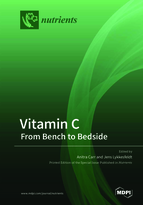Vitamin C: From Bench to Bedside
A special issue of Nutrients (ISSN 2072-6643). This special issue belongs to the section "Micronutrients and Human Health".
Deadline for manuscript submissions: closed (31 December 2020) | Viewed by 146550
Special Issue Editors
Interests: vitamin C; intake recommendations; respiratory infections; immune function; diabetes; metabolic health; mood; cognitive health; health-related quality of life
Special Issues, Collections and Topics in MDPI journals
Interests: vitamin C; recommendations; effects of vitamin deficiency; lifestyle diseases
Special Issues, Collections and Topics in MDPI journals
Special Issue Information
Dear Colleagues,
Vitamin C (ascorbic acid) is a normal liver metabolite in most animals, with humans being a notable exception due to random genetic mutations that have occurred during our evolution. As such, it has become a vitamin (vital to life), with requirements increasing significantly during various illnesses, particularly severe infections. Recent international clinical trials are highlighting the potential for intravenous vitamin C administration to improve clinical outcomes for patients, particularly those with severe respiratory illness and sepsis, and some cancers. Furthermore, there has been an upsurge in new discoveries and new mechanistic insights, particularly around epigenetic regulation by vitamin C, that are providing rationales for future targeted clinical trials. Other areas with potential benefit from vitamin C include metabolic disorders and mental health. The health benefits from increased vitamin C could be dramatic as the prevalence of these conditions continues to rise. What is needed moving forward are well designed observational and interventional studies, which take into account baseline status and the unique pharmacokinetics of vitamin C, to help address the current gaps in our knowledge. Underpinning mechanistic research will also further our ability to inform good clinical practice.
Assoc. Prof. Anitra Carr
Guest Editor
Manuscript Submission Information
Manuscripts should be submitted online at www.mdpi.com by registering and logging in to this website. Once you are registered, click here to go to the submission form. Manuscripts can be submitted until the deadline. All submissions that pass pre-check are peer-reviewed. Accepted papers will be published continuously in the journal (as soon as accepted) and will be listed together on the special issue website. Research articles, review articles as well as short communications are invited. For planned papers, a title and short abstract (about 100 words) can be sent to the Editorial Office for announcement on this website.
Submitted manuscripts should not have been published previously, nor be under consideration for publication elsewhere (except conference proceedings papers). All manuscripts are thoroughly refereed through a single-blind peer-review process. A guide for authors and other relevant information for submission of manuscripts is available on the Instructions for Authors page. Nutrients is an international peer-reviewed open access semimonthly journal published by MDPI.
Please visit the Instructions for Authors page before submitting a manuscript. The Article Processing Charge (APC) for publication in this open access journal is 2900 CHF (Swiss Francs). Submitted papers should be well formatted and use good English. Authors may use MDPI's English editing service prior to publication or during author revisions.
Keywords
- cancer
- quality of life
- epigenetics
- infection
- sepsis
- inflammation
- immune function
- metabolic health
- cognitive function
- mental health








